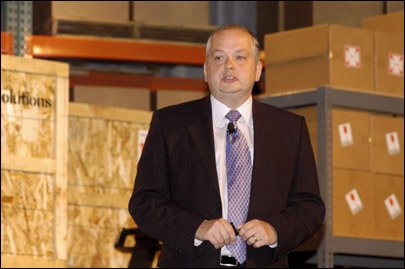Wal-Mart says that by the end of this month, it will have installed radio frequency identification systems in more than 500 stores and five distribution centers. The retail giant is currently requiring its top 100 suppliers to ship tagged pallets and cases of specific stock-keeping units (SKUs) to three distribution centers and some 150 stores in the Texas area. It is now working with those suppliers to get them to put RFID tags carrying Electronic Product Codes (EPCs) on more SKUs, and to deliver tagged products to stores and distribution centers in new regions of the United States.
“We’ll be working with our suppliers, as we’ve done the last 18 months, to expand the number of SKUs they are tagging,” says Simon Langford, manager of RFID strategies for Wal-Mart. “We have a number of suppliers tagging 100 percent of their SKUs—they’re there already—so it’s working with those that are tagging less than that to step them up.”

Langford says the recent fall in prices of EPC tags means tag cost will no longer be a big inhibitor to adoption. “When we sat down with our top 100 suppliers, we asked those that were tagging less than 100 percent of their SKUs what [changes] would enable them to get to 100 percent,” he explains. “Tag costs were a major factor, for example. Some felt that only a 15-cent or 10-cent tag was economically viable for some products. We’re now seeing costs come down below that, and there’s no reason why they can’t tag those products.”
Wal-Mart announced today that it would continue its rollout during 2006, doubling the number of its RFID-enabled stores, as well as RFID-enabling the distribution centers servicing those stores. By the end of 2006, more than 1,000 stores and distribution centers will be RFID-enabled. “As we start to implement RFID [in new stores and DCs] next year,” says Langford, “we would expect our suppliers to ship tagged products to those stores. We’ll be working with them to achieve that.”
As it previously announced, Wal-Mart will begin receiving tagged pallets and cases from its next top 200 suppliers in January 2006. It has been collaborating with these suppliers, as it did with its top 100, to coordinate the tagging of shipments. The retailer says a number of the “next 200” that went live in January 2005 have participated together in gatherings with Wal-Mart, explaining what lessons they learned and what benefits they achieved.
Wal-Mart expects the next wave of 300 suppliers to start shipping tagged cases and pallets by January 2007, at which point more than 600 suppliers in total will be tagging shipments to Wal-Mart by early 2007.
Langford adds that Wal-Mart has been testing Gen 2 EPC tags and interrogators (readers) in its Bentonville, Ark., RFID lab, and has found that the new protocol succeeds in improving the ability to read tags on products moving on conveyors and through dock doors. As a result, Wal-Mart plans to phase out the use of Gen 1 products in its supply chain by the middle of next year.
“We polled our top suppliers to see what level of tags they have on hand,” Langford says. “The vast majority would be in a position to use Gen 2 in the early part of next year. There are a few suppliers that have more tags than that. But a couple said they have just started testing Gen 2 and probably can move to it faster than they originally anticipated. With the improved performance, we want to move to Gen 2 as fast as possible.”
While some top 100 suppliers had initially grumbled at having to invest in RFID tags, Langford believes that some will be eager to tag additional products, thanks to a recent research study showing that tagging improves on-shelf availability (see EPC Reduces Out-of-Stocks at Wal-Mart). “Given the benefits we’re seeing,” he says, “I think a number of suppliers will want to tag more product, especially when you consider the phenomenal reduction in tag costs we’re seeing.”

